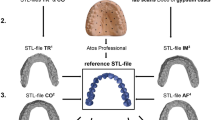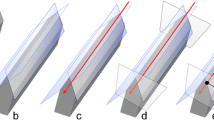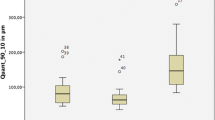Abstract
Objectives
Comparison of full-arch digital impressions to conventional impressions in vitro and in vivo.
Materials and methods
A straight metal bar was fixed between the second upper molars as a reference structure in the mouth of a voluntary patient and a corresponding polymer model. The following digitalization methods were applied: (1) the maxilla was digitized in vivo 12 times with the iTero Element (P-SCAN); (2) the maxilla was captured in vivo 12 times by conventional impression and the impression was digitized by a desktop scanner (P-IMP); (3) the impressions were poured and the 12 referring gypsum master-casts were scanned with the same desktop scanner (P-CAST); (4) the polymer model was digitized in vitro 12 times with the iTero Element (M-SCAN); (5) the polymer model was captured in vitro 12 times by conventional impression and the impression was digitized by a desktop scanner (M-IMP); (6) the impressions were poured and the 12 referring gypsum master-casts were scanned with the same desktop scanner (M-CAST). Datasets were exported and metrically analyzed (Geomagic Control X) to determine three-dimensional length aberration and angular distortion versus the reference structure. Mann–Whitney U test was implemented to detect differences (p < 0.05).
Results
For multiple accuracy parameters, P-SCAN and M-SCAN showed similar or superior results compared to the other digitalization methods. The following length deviations were found: M-SCAN (− 55 to 80 μm), M-IMP (110 to 329 μm), M-CAST (88 to 178 μm), P-SCAN (− 67 to 76 μm), P-IMP (125–320 μm), and P-CAST (92–285 μm).
Conclusions
Within the limitations of this study, the iTero-scan seems to be a valid alternative to conventional impressions for full arches.
Clinical relevance
Intraoral scanners are more and more used in daily routine; however, little is known about their accuracy when it comes to full-arch scans. Under optimum conditions, the direct digitalization using the iTero Element intraoral scanning device results in the same and for single parameters (arch width and arch distortion) even in higher accuracy than the indirect digitalization of the impression or the gypsum cast using a desktop scanner.





Similar content being viewed by others
References
Kuhr F, Schmidt A, Rehmann P, Wostmann B (2016) A new method for assessing the accuracy of full arch impressions in patients. J Dent 55:68–74. https://doi.org/10.1016/j.jdent.2016.10.002
Edelhoff D, Schweiger J, Prandtner O, Trimpl J, Stimmelmayr M, Guth JF (2017) CAD/CAM splints for the functional and esthetic evaluation of newly defined occlusal dimensions. Quintessence Int 48(3):181–191. https://doi.org/10.3290/j.qi.a37641
Edelhoff D, Beuer F, Schweiger J, Brix O, Stimmelmayr M, Guth JF (2012) CAD/CAM-generated high-density polymer restorations for the pretreatment of complex cases: a case report. Quintessence Int 43(6):457–467
Güth JF, Almeida e Silva JSA, Beuer FF, Edelhoff D (2012) Enhancing the predictability of complex rehabilitation with a removable CAD/CAM-fabricated long-term provisional prosthesis: a clinical report. J Prosthet Dent 107(1):1–6. https://doi.org/10.1016/S0022-3913(11)00171-5
Keul C, Stawarczyk B, Erdelt KJ, Beuer F, Edelhoff D, Guth JF (2014) Fit of 4-unit FDPs made of zirconia and CoCr-alloy after chairside and labside digitalization—a laboratory study. Dent Mater 30(4):400–407. https://doi.org/10.1016/j.dental.2014.01.006
Ender A, Mehl A (2011) Full arch scans: conventional versus digital impressions—an in-vitro study. Int J Comput Dent 14(1):11–21
Guth JF, Keul C, Stimmelmayr M, Beuer F, Edelhoff D (2013) Accuracy of digital models obtained by direct and indirect data capturing. Clin Oral Investig 17(4):1201–1208. https://doi.org/10.1007/s00784-012-0795-0
Guth JF, Edelhoff D, Schweiger J, Keul C (2016) A new method for the evaluation of the accuracy of full-arch digital impressions in vitro. Clin Oral Investig 20(7):1487–1494. https://doi.org/10.1007/s00784-015-1626-x
Mehl A, Ender A, Mormann W, Attin T (2009) Accuracy testing of a new intraoral 3D camera. Int J Comput Dent 12(1):11–28
Nedelcu RG, Persson AS (2014) Scanning accuracy and precision in 4 intraoral scanners: an in vitro comparison based on 3-dimensional analysis. J Prosthet Dent 112(6):1461–1471. https://doi.org/10.1016/j.prosdent.2014.05.027
Boeddinghaus M, Breloer ES, Rehmann P, Wostmann B (2015) Accuracy of single-tooth restorations based on intraoral digital and conventional impressions in patients. Clin Oral Investig 19(8):2027–2034. https://doi.org/10.1007/s00784-015-1430-7
Gimenez B, Ozcan M, Martinez-Rus F, Pradies G (2015) Accuracy of a digital impression system based on active wavefront sampling technology for implants considering operator experience, implant angulation, and depth. Clin Implant Dent Relat Res 17(Suppl 1):e54–e64. https://doi.org/10.1111/cid.12124
Gimenez B, Pradies G, Martinez-Rus F, Ozcan M (2015) Accuracy of two digital implant impression systems based on confocal microscopy with variations in customized software and clinical parameters. Int J Oral Maxillofac Implants 30(1):56–64. https://doi.org/10.11607/jomi.3689
Amin S, Weber HP, Finkelman M, El Rafie K, Kudara Y, Papaspyridakos P (2017) Digital vs. conventional full-arch implant impressions: a comparative study. Clin Oral Implants Res 28(11):1360–1367. https://doi.org/10.1111/clr.12994
Ciocca L, Meneghello R, Monaco C, Savio G, Scheda L, Gatto MR, Baldissara P (2018) In vitro assessment of the accuracy of digital impressions prepared using a single system for full-arch restorations on implants. Int J Comput Assist Radiol Surg 13:1097–1108. https://doi.org/10.1007/s11548-018-1719-5
Jeong ID, Lee JJ, Jeon JH, Kim JH, Kim HY, Kim WC (2016) Accuracy of complete-arch model using an intraoral video scanner: an in vitro study. J Prosthet Dent 115(6):755–759. https://doi.org/10.1016/j.prosdent.2015.11.007
Patzelt SB, Emmanouilidi A, Stampf S, Strub JR, Att W (2014) Accuracy of full-arch scans using intraoral scanners. Clin Oral Investig 18(6):1687–1694. https://doi.org/10.1007/s00784-013-1132-y
Ender A, Mehl A (2015) In-vitro evaluation of the accuracy of conventional and digital methods of obtaining full-arch dental impressions. Quintessence Int 46(1):9–17. https://doi.org/10.3290/j.qi.a32244
Ender A, Mehl A (2013) Accuracy of complete-arch dental impressions: a new method of measuring trueness and precision. J Prosthet Dent 109(2):121–128. https://doi.org/10.1016/S0022-3913(13)60028-1
Zimmermann M, Koller C, Rumetsch M, Ender A, Mehl A (2017) Precision of guided scanning procedures for full-arch digital impressions in vivo. J Orofac Orthop 78(6):466–471. https://doi.org/10.1007/s00056-017-0103-3
Flugge TV, Schlager S, Nelson K, Nahles S, Metzger MC (2013) Precision of intraoral digital dental impressions with iTero and extraoral digitization with the iTero and a model scanner. Am J Orthod Dentofac Orthop 144(3):471–478. https://doi.org/10.1016/j.ajodo.2013.04.017
Ender A, Attin T, Mehl A (2016) In vivo precision of conventional and digital methods of obtaining complete-arch dental impressions. J Prosthet Dent 115(3):313–320. https://doi.org/10.1016/j.prosdent.2015.09.011
Grunheid T, McCarthy SD, Larson BE (2014) Clinical use of a direct chairside oral scanner: an assessment of accuracy, time, and patient acceptance. Am J Orthod Dentofac Orthop 146(5):673–682. https://doi.org/10.1016/j.ajodo.2014.07.023
Accuracy (trueness and precision) of measurement methods and results—part 1: general principles and definitions (ISO 5725-1:1994)
Choi AH, Conway RC, Taraschi V, Ben-Nissan B (2015) Biomechanics and functional distortion of the human mandible. J Investig Clin Dent 6(4):241–251. https://doi.org/10.1111/jicd.12112
Sahin S, Cehreli MC (2001) The significance of passive framework fit in implant prosthodontics: current status. Implant Dent 10(2):85–92
van der Meer WJ, Andriessen FS, Wismeijer D, Ren Y (2012) Application of intra-oral dental scanners in the digital workflow of implantology. PLoS One 7(8):e43312. https://doi.org/10.1371/journal.pone.0043312
Wesemann C, Muallah J, Mah J, Bumann A (2017) Accuracy and efficiency of full-arch digitalization and 3D printing: a comparison between desktop model scanners, an intraoral scanner, a CBCT model scan, and stereolithographic 3D printing. Quintessence Int 48(1):41–50. https://doi.org/10.3290/j.qi.a37130
Muallah J, Wesemann C, Nowak R, Robben J, Mah J, Pospiech P, Bumann A (2017) Accuracy of full-arch scans using intraoral and extraoral scanners: an in vitro study using a new method of evaluation. Int J Comput Dent 20(2):151–164
Nowak R, Wesemann C, Robben J, Muallah J, Bumann A (2017) An in-vitro study comparing the accuracy of full-arch casts digitized with desktop scanners. Quintessence Int 20:667–676. https://doi.org/10.3290/j.qi.a38676
Persson AS, Oden A, Andersson M, Sandborgh-Englund G (2009) Digitization of simulated clinical dental impressions: virtual three-dimensional analysis of exactness. Dent Mater 25(7):929–936. https://doi.org/10.1016/j.dental.2009.01.100
Matta RE, Adler W, Wichmann M, Heckmann SM (2017) Accuracy of impression scanning compared with stone casts of implant impressions. J Prosthet Dent 117(4):507–512. https://doi.org/10.1016/j.prosdent.2016.07.026
Rehmann P, Sichwardt V, Wostmann B (2017) Intraoral scanning systems: need for maintenance. Int J Prosthodont 30(1):27–29. https://doi.org/10.11607/ijp.4976
Funding
The conduct of the present study was financially supported by Align Technology. Align Technology had no influence in the study design, nor in the collection, analysis, or interpretation of the data, nor in writing or submitting the publication.
Author information
Authors and Affiliations
Corresponding author
Ethics declarations
Conflict of interest
The conduct of the present study was financially supported by Align Technology. Align Technology had no influence in the study design, nor in the collection, analysis, or interpretation of the data, nor in writing or submitting the publication.
Ethical approval
This study was approved by the Ethics Committee (511-14) and registered at the German Clinical Trial Register (DRKS 00015459). All procedures performed in this study were in accordance with the ethical standards of the institutional and/or national research committee and with the 1964 Helsinki declaration and its later amendments or comparable ethical standards.
Informed consent
Before starting the data acquisition, the voluntary patient signed an informed consent.
Additional information
Publisher’s note
Springer Nature remains neutral with regard to jurisdictional claims in published maps and institutional affiliations.
Rights and permissions
About this article
Cite this article
Keul, C., Güth, JF. Accuracy of full-arch digital impressions: an in vitro and in vivo comparison. Clin Oral Invest 24, 735–745 (2020). https://doi.org/10.1007/s00784-019-02965-2
Received:
Accepted:
Published:
Issue Date:
DOI: https://doi.org/10.1007/s00784-019-02965-2




